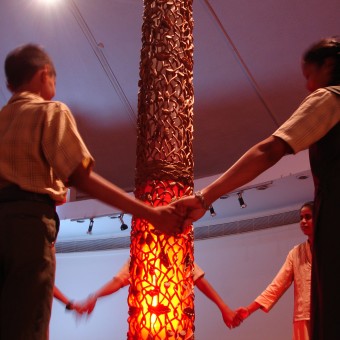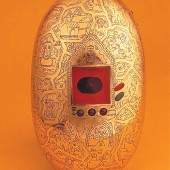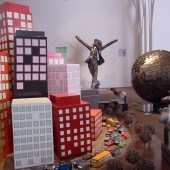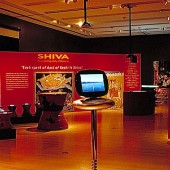DESIGN NAME:
Sacred Touch
PRIMARY FUNCTION:
Exhibition Design
INSPIRATION:
Sacred Arts, Asian Wisdom, Californian Creativity
UNIQUE PROPERTIES / PROJECT DESCRIPTION:
Sacred Touch: Museums designed by the Sacred World Foundation. • The Crossing Project: Living, Dying, and Transformation in Banaras • Eternal Gandhi Multimedia Museum • Planet Health. • Star Museum Museum that show Interactive Art and Technology, Traditional Crafts and Modern Design. The works explore an intersection between traditional arts and crafts and modern design and technology. This synthesis can help developing and developed worlds in many ways: - the wisdom of traditional communities can positively negate the homogenizing influences of modern technology; and - the intelligence and creativity afforded by modern technology can reciprocally help traditional artists. This has been mirrored in many of my recent works: The Crossing, the Eternal Gandhi Museum, the Planet Health Museum, and Goddess and Temples of Music. The works explore an intersection between traditional arts and crafts and modern design and technology. This synthesis can help developing and developed worlds in many ways: - the wisdom of traditional communities can positively negate the homogenizing influences of modern technology; and the intelligence and creativity afforded by modern technology can reciprocally help traditional.
Integration of the wisdom of traditional arts and crafts and modern design and technology.
Reciprocally helping / aiding traditional arts.
New form of experience involving modern and traditional interactions.
OPERATION / FLOW / INTERACTION:
Developing an Interactive Multimedia Museum showcasing pioneering documentations of multimedia computing with the finest of first of Asian hand skills.
Museum inspires the world about fundamental themes relating to technology, spirituality, and social equity.
PROJECT DURATION AND LOCATION:
• Eternal Gandhi Multimedia Museum = 2003 – 2005, New Delhi, India
• The Crossing Project = 8000 sqft = 2000-2002, New Delhi, India
• Planet Health Museum = 2010, New Delhi, India
• Star Museum = 2008-2011, Rajastan, India
FITS BEST INTO CATEGORY:
Interface, Interaction and User Experience Design
|
PRODUCTION / REALIZATION TECHNOLOGY:
Asian handicrafts
Custom embedded computing technology
SPECIFICATIONS / TECHNICAL PROPERTIES:
• Eternal Gandhi Multimedia Museum = 8000 sqft
• The Crossing Project = 8000 sqft
• Planet Health Museum = 20,000 sqft
• Star Museum = 8000 sqft
TAGS:
Ranjit Makkuni, Sacred World, Eternal Gandhi, Planet Health, Crossing Project
RESEARCH ABSTRACT:
While majority of people in developed economies live in an urbanized environment, most people in developing nations live in villages. Such 'Nature' based communities across the globe hold deep commitments to hand based skills and livelihood.
The works explore an intersection between traditional arts and crafts and modern design and technology. This synthesis can help developing and developed worlds in many ways:
- the wisdom of traditional communities can positively negate the homogenizing influences of modern technology; and
- the intelligence and creativity afforded by modern technology can reciprocally help traditional artists.
This has been mirrored in many recent works: The Crossing, the Eternal Gandhi Museum, the Planet Health Museum, and Goddess and Temples of Music.
These works demonstrate new trajectories in Computing, Design and Development.
• First, the works show 'cultural computers', how large volume computers can disappear, and, through redesign, reappear as cultural computers, so that people interact with objects of “meaning” and have the ability to personalize their technology.
• Second, with respect to User Interface, in my works, peoples’ intuitive ability to interact with physical objects in physical space becomes the digital interface. As a result, the computers designed naturally respond
to touch,
to texture,
to motion,
to physical manipulation,
as also to breath,
voice,
and song.
• Third, the works explore the inclusion of village aesthetics and creativity in the design of new technology, exploring an equitable model of development wherein commitments to innovation and traditional culture go hand in hand.
CHALLENGE:
The Sacred World Foundation is a think-tank exploring technology and design innovation created by building bridges between techno-and traditional cultures.
Over the past decade it has produced pioneering, award winning, provocative demonstrations of technology and cultural documentation focused on important cultural themes, such as the sacred geography of Banaras, the representation of the Sacred Feminine, a re-examination of of Gandhian philosophy, Green consciousness, Ayruveda and Yoga health traditions.
Even though our earlier work projected radical innovation, technologies that have been distinctively different from its predecessors, with time and the world 's current eco and spiritual context, our model of innovation in the current context is framed in questions of ecological sustainability, green methods, and the ability to support village arts and aesthetics.
ABOUT US
Sacred World’s works put forth a model of development in which commitment to technological innovation and cultural worldview goes hand in hand.
Through direct engagement with traditional arts, the Sacred World develops a voice for the preservation of hand skills and ‘heart’ based creativity, which is the substratum of traditional arts and crafts.
The works of the Sacred World illustrate valuable bridges between traditional arts, contemporary design and information technology.
ADDED DATE:
2012-02-26 23:31:57
TEAM MEMBERS (9) :
PROJECT DIRECTOR, CONCEPT, DESIGN AND DIRECTION, Ranjit Makkuni, , , PROJECT SCHOLAR, Madhu Khanna, For full credits, see: www.sacredworld.com and
IMAGE CREDITS:
Makkuni Ranjit, 2011.
|









